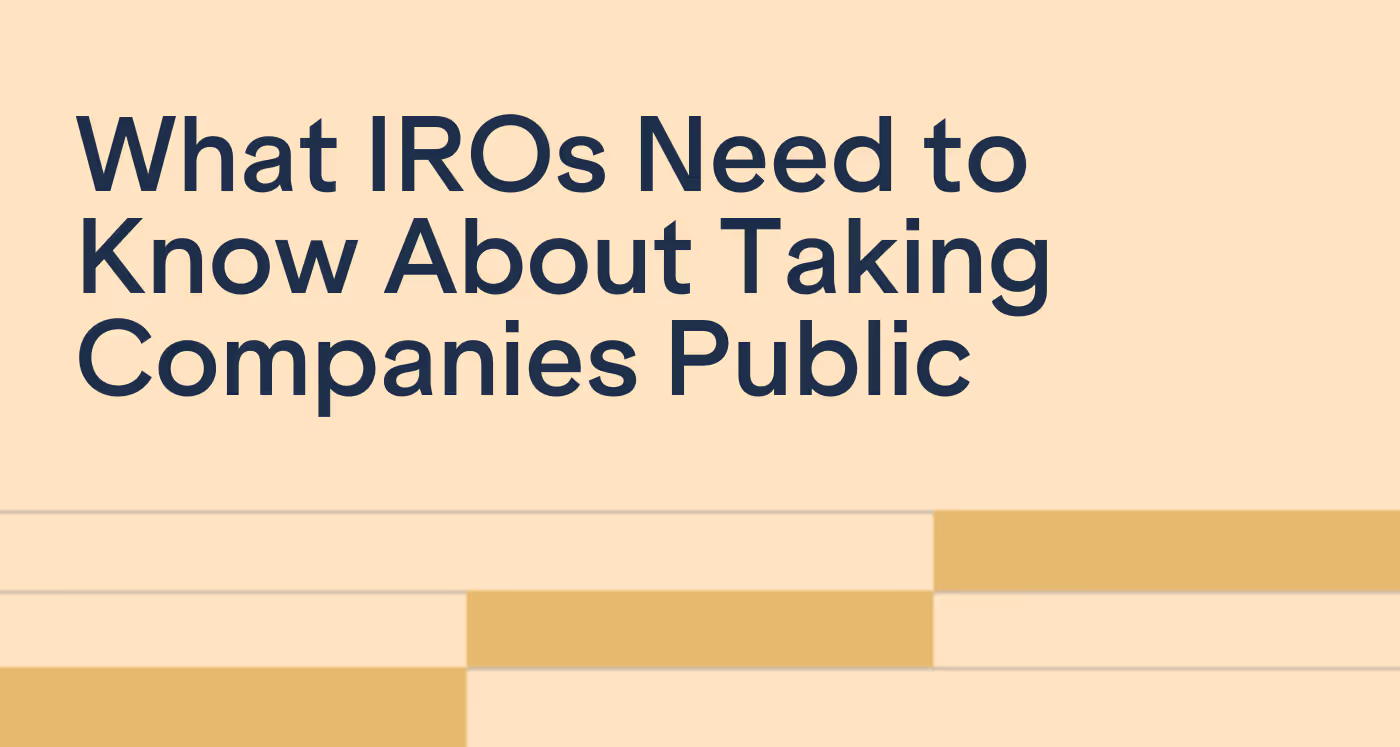
How to Build Effective Investor Targeting and Outreach Strategies for Small-Mid-Cap Companies
Learn how seasoned IR veterans are executing targeting strategies for small-mid-cap companies.

Welcome to proxy season. The time of year when publicly-traded companies host annual general shareholder meetings (AGM) and vote on the most important issues facing issuers, investors and other stakeholders.
With a growing amount of shareholder proposals each year, proactive investor relations is more important than ever, as unprepared companies could face pressure from all sides.
So how can IROs effectively manage their organization's shareholder base and maximize their impact during proxy season? It all comes down to understanding who your shareholders are and having the right tools to do so.
As you navigate your AGM this year, Irwin can support you and your IR strategy by:
We’ve also included insights from Christine Carson—President & CEO of Carson Proxy—as she shares her expert advice on how proxy advisors can assist companies and what they bring to the table in terms of managing a proxy campaign with an IRO or General Counsel.

Proxy season is a critical time for publicly traded companies, as it marks the annual shareholder meetings where shareholders vote on important corporate matters. Falling in the spring, typically between April and June, proxy season is an opportunity for investor relations professionals to communicate with shareholders and provide them with the information needed to make informed voting decisions.
See Also: Expert’s’ Top Tips for IR Storytelling and Corporate Communications
AGMs are important because they allow shareholders to have a say in a company's decision-making process. The outcome of the shareholder votes can significantly impact the company's future direction, governance, and financial performance.
How a company conducts its proxy season and interacts with shareholders can also affect its reputation and investor confidence. To be effective during proxy season, IR professionals can take the following steps:
Ensure that you clearly understand your shareholder base’s wants and needs, the proposals being put to vote, the company's position on each, and the reasons behind it. This will help you effectively communicate with your shareholders and address any questions or concerns. For best results, consider a proactive investor outreach strategy that gives you year-round insights into your shareholder base.

Develop clear and concise messaging that communicates the company's position on each proposal and the reasons behind it. Use various channels, including emails, webcasts, and telephone calls to reach out to shareholders and ensure they have all the information they need to make informed voting decisions.
Encourage two-way communication between the company and its shareholders. Respond to shareholder questions and concerns promptly and professionally, and consider scheduling 1 x 1 calls or conference calls with your shareholders to provide additional information.
Be transparent and provide clear and accurate information to shareholders. This can build trust and confidence in the company and enhance its reputation.
After the shareholder meeting, follow up with shareholders to address any questions or concerns they may have and provide a summary of the results of the voting
By following these steps, professionals can be effective during proxy season and help ensure that the company's interests are protected and that the shareholder voting process is conducted smoothly.

When reviewing your shareholder base ahead of an annual general shareholder meeting, it's important to consider the following factors:
Identify any institutional shareholders and their voting policies. This information can help you engage with them and understand their perspectives on key issues.
Assess the level of engagement you have with your shareholders. Identify any gaps and find ways to increase engagement and build stronger relationships with your shareholders. Use Irwin’s Shareholder Monitoring tools to detect reporting and non-reporting shareholders.
Identify your shareholders' geographic locations, industries, and sizes. This information can help you tailor your communication and engagement strategies to meet their specific needs and interests.
Review the voting patterns of your shareholders from previous shareholder meetings. This will help you understand their tendencies and predict how they may vote in the upcoming meeting.
Monitor potential activist shareholders who may be seeking to influence the outcome of the shareholder meeting. This information can help you prepare responses to their demands and address any potential challenges.
See Also: The Ultimate Guide to Shareholder Activism
Keep track of any changes in your shareholder base, such as new investors, reductions in ownership, or changes in institutional ownership. These changes can impact the outcome of the shareholder meeting and should be taken into consideration.
By considering these factors, you can better understand your shareholder base ahead of the annual general shareholder meeting, be better prepared to engage with them and ensure that the shareholder voting process is conducted smoothly.
.avif)
Shareholder filings can provide valuable information that IR teams can leverage during proxy season in several ways, including:
Overall, leveraging reported shareholder filings during proxy season can help IROs better understand their shareholder base, identify potential risks and opportunities, and engage with shareholders more effectively.

With the assistance of an IR CRM, IROs can get transparency and insight into their shareholder base. For example, Irwin provides users with deep ownership insights including reported positions, NOBO data, stock surveillance, and custom holdings—all of which help users maintain relationships and regular communication with key shareholders.
When an investor opens an account with a bank or a broker, they must disclose whether or not they object to being a beneficial owner. Those who choose to be non-objecting beneficial owners (NOBO) agree to have information such as their name, address, and share count provided upon request of the issuer. Objecting beneficial owners object to having this information shared.
Historically, companies have ordered NOBO lists during their AGM for proxy solicitation. However, NOBO lists are increasingly being used for shareholder monitoring and targeting. They are often retail investors but can also include family offices and funds.
Did you know that a current shareholder is 9x more likely to increase their position than a new investor is to acquire a position? Having a line of sight to your non-reporting shareholders is crucial for running a successful IR program.
NOBO lists can be an exceptionally valuable resource for IROs and their organization during proxy season. Here are some ways in which you can leverage NOBO data:
See Also: Why You Should Track Your NOBO Shareholders
Overall, leveraging NOBO data during proxy season can help IR teams improve their outreach and engagement efforts, increase shareholder participation in critical votes, and ensure regulatory compliance.
.avif)
All-in-all, IROs should be taking advantage of the benefits of an IR CRM—especially when preparing for proxy season. With the support of Irwin, IR teams can build strong relationships with investors and effectively navigate the complex tasks of managing annual general shareholder meetings, ultimately leading to improved shareholder value and company success.
Learn how Irwin's shareholder monitoring helps issuers stay ahead of proxy season challenges.

Learn how seasoned IR veterans are executing targeting strategies for small-mid-cap companies.

Elizabeth Librizzi breaks down the secrets of buy-side corporate access to help investor relations professionals utilize buy-side firms.

What IROs Need to Know About Taking Companies Public: Insights from award winning investor relations thought leader Catherine Buan.